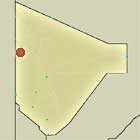Gharagab
- Price
- Accommodation
- Extra Information
- Terms & Conditions
Guide to accommodation descriptions
Gharagab
location in Kgalagadi
Kgalagadi Transfrontier Park - Wilderness Camps
Gharagab Wilderness Camp
Located in the far northern region of the park, will provide guests with elevated views of Kalahari dunes and the thornveld savannah. Situated 164 km (four hours) drive north of Nossob on the road to Unions End. The closest shop and fuel supply is at Nossob, where guests who have booked Gharagab also checks in. The camp is unfenced, and there is a tourism assistant on duty. Gharagab is ususally accessible by 2x4 and 4x4 vehicles on a one way road. It is not suitable for normal sedan vehicles, and it's advisable to contact the park before your trip to ascertain the prevailing conditions.
Accommodation
Log Cabins
- Each unit has 2 single beds, a bathroom with w/c and shower, an equipped kitchen with gas fridge / freezer, solar power for lights, gas for hot water and barbeque facilities on a deck.
- Guests have to provide their own drinking water and firewood.
Extra Information
Day travellers
There are communal ablution facilities at Twee Rivieren, Nossob and Mata Mata rest camps and picnic sites at Melkvlei, 50 km (north of Twee Rivieren), Dikbaardskolk, 56 km (South of Nossob) and at Kamqua between Twee Rivieren and Mata-Mata.
Handy Hints
- Binoculars and cameras should be easily accessible at all times
- Stopping for little things often produces interesting things that were not apparent.
- Sun cream is advisable
- Drinking water available in all shops
Official hours
Office Hours - 07:30 to sundown
Gate Hours
| Gate Times | Jan - Feb | Mar | Apr | May | Jun-Jul | Aug | Sep | Oct | Nov-Dec |
| Gates Open | 05:30 | 06:30 | 07:00 | 06:00 | 06:00 | 06:00 | 06:30 | 06:00 | 05:30 |
| Gates Close | 19:30 | 19:00 | 18:30 | 06:00 | 06:00 | 06:00 | 18:30 | 19:00 | 19:30 |
Take note
- Pets are not allowed in a National Park.
- Firearms must be declared at the gate where they will be sealed. The seal will be broken upon departure.
- Shoes are essential on summer evenings for protection against the possibility of scorpion stings.
- Keep an emergency supply of 10 litres water in your vehicle.
- In the event of a breakdown, remain in your vehicle – it is the safest place.
- This is a low risk malaria area. Consult your chemist.
- Roads in the park have gravel surfaces.
- Light aircraft may land on a tarred runway at Twee Rivieren. Prior permission must be obtained from the Park.
- Hired cars may be collected at Twee Rivieren provided that an advance booking was made.
- The travelling time from the entrance gate at Twee Rivieren to Nossob Rest Camp is 3.5 hours and to Mata Mata is 2.5 hours. When driving from one rest camp to the other, travellers should depart with travelling times in mind to ensure arrival before sunset as no travelling is allowed in the park after dark.
Visitors to Botswana
Until such time as the entrance gate into Kgalagadi Transfrontier National Park is completed (the amalgamation of Kalahari Gemsbok National Park, South Africa and Gemsbok National Park, Botswana) the following procedure still has to be followed. Visitors visiting the Park have no need for a passport unless the park is exited via a different gate than entry. A passport is essential when entrance from one country and departure to another will be undertaken. For this purpose, a border post is situated at Twee Rivieren on the South African side and at Two Rivers on the Botswana side of the Park. (Twee Rivieren border post office hours: 07:30 – 16:00).
Guests utilising Botswana trails and campsites must be in possession of the correct permits obtained through Botswana Central Reservations.
Climate
The Kalahari is a semi-arid region with an average rainfall of 150mm in the southwest to 350mm in the northeast. The unreliable and irregular rains fall mostly during dramatic thunderstorms, often accompanied by strong winds and dust-storms, between November and April. The first rains transform the red dunes, covering them with the fresh yellow flowers of the dubbeltjie, Tribulus terrestris. Within two weeks fresh green grass begins to grow, but if the rains do not return, the vegetation will soon wither and the thirstland once again becomes apparent.
Temperatures vary greatly from -11°C on cold winter nights to 42°C in the shade on summer days when the ground surface temperature reaches a sizzling 70°C. During the winter months, when frost is common, the ground surface temperature can be 25°C lower that the temperature of the air. Winter in the Kalahari is a cool, dry season from September to October and then a hot, wet season from November to April.

